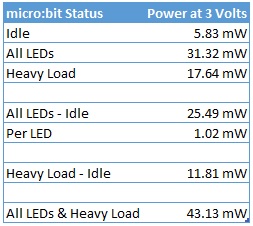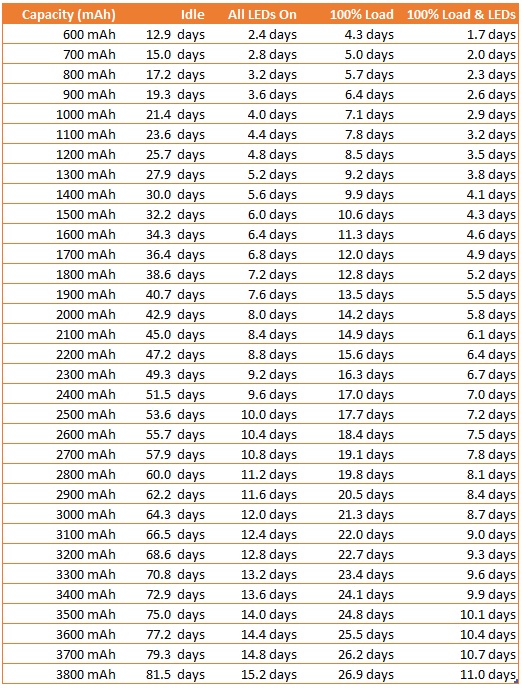In our recent blog post: micro:bit Power Consumption, we look at how much power the micro:bit draws at different input voltages while idle, illuminating the full array of 25 LEDs, or with the processor operating at 100% load carrying out calculations. In this post, we will look at how this power consumption relates to battery life.
The micro:bit is supplied with a 2xAAA battery holder. Assuming that the majority of users will put a pair of good quality alkaline cells into this battery holder for powering their micro:bit projects, we will use 3 Volts as the input voltage in the calculations to follow. Good alkaline cells start off at just over 1.5 Volts and maintain this voltage until it begins to drop off only when the cells are almost depleted of charge. (The calculations would be quite different if rechargeable NiMH cells were to be used for example since with an input voltage of 2.4-2.5V, the power consumption is notably lower.)
Referring to the table of power consumption results (available in the post linked to at the top of this post), with 3 Volts on the input we saw the following:
 i.e. at idle (minimal processing and no LEDs on), power consumption is just 5.83mW, but with the processor working at 100% and all of the LEDs on, power consumption is over 43mW.
i.e. at idle (minimal processing and no LEDs on), power consumption is just 5.83mW, but with the processor working at 100% and all of the LEDs on, power consumption is over 43mW.
Good quality AAA cells typical hold a charge of somewhere from 800-1000mAh, AA cells from 1800-2400mAh. There are higher capacity cells available, but these are usually optimised for use with digital cameras and similar supplying high current briefly each time a picture is taken rather than the steady state constant low current typical for a micro:bit project. They also tend to be much more expensive.
 The table above takes the power consumption data previously measured with a 3 Volt input voltage and shows for how many days the battery pack will last for a wide selection of different capacities. For example, if you had a processor intensive project which made use of all or nearly all of the LEDs at once, and a pair of 1000mAh Duracell Plus AAA cells, you could expect to get approximately 3 days of battery life. If on the other hand you had a project which was not processor intensive, did not make use of the LEDs, and used a pair of 2400mAh AA cells, you could expect around 50 days of battery life.
The table above takes the power consumption data previously measured with a 3 Volt input voltage and shows for how many days the battery pack will last for a wide selection of different capacities. For example, if you had a processor intensive project which made use of all or nearly all of the LEDs at once, and a pair of 1000mAh Duracell Plus AAA cells, you could expect to get approximately 3 days of battery life. If on the other hand you had a project which was not processor intensive, did not make use of the LEDs, and used a pair of 2400mAh AA cells, you could expect around 50 days of battery life.
There are many factors above which will affect the real world battery life including the ambient temperature, the specific features of the project to be built, and of course any additional components, sensors, or devices to be powered at the same time as the micro:bit. However, it will hopefully give you a pretty accurate idea of what to expect and to inform your choices when you are choosing how to power your project.
Bookmark microbit.me.uk to view all our previous and future micro:bit related articles.